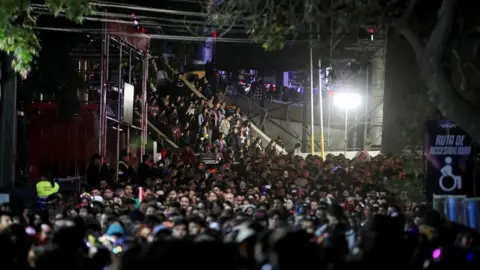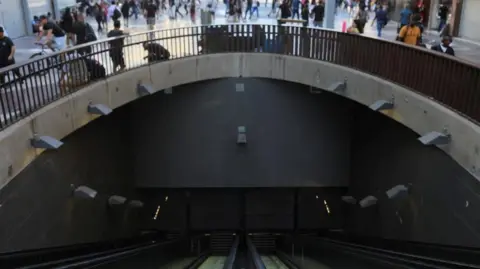
Title: Massive Power Outage Hits Chile, Disrupting Thousands of Lives and Events
By: Vanessa Buschschlüter, BBC News

People leave the amphitheater of the International Song Festival after the show was interrupted due to a blackout in Viña del Mar, Chile, on February 25, 2025. (Reuters)
On Tuesday afternoon, a significant electricity transmission line failure resulted in over eight million households across Chile losing power. The outage impacted a vast portion of the nation, including the capital city, Santiago, where the entire subway system was halted almost immediately, plunging many of its stations into darkness and forcing thousands to evacuate.
Describing the eerie scene, one traveler recounted, “We felt like sardines in the dark,” as their subway train came to an unexpected halt. Simultaneously, emergencies unfolded in the stations where numerous individuals were trapped in elevators, requiring assistance from firefighters to be freed. Among those requiring rescue was a woman in her 70s who found herself trapped between floors.

A woman is released from the lift during the power outage in Chile, visibly relieved by the firefighters’ efforts. (Getty Images)
Once rescued, she recounted her frightening experience to local media, revealing, “I kicked the door of the lift to attract attention, and my cries eventually caught the concierge’s notice.” She added, “I was brave, telling myself, ‘I won’t die here.’”
Social media platforms quickly became a hub for sharing videos of metro passengers using mobile flashlights to navigate through the darkened stations.

With lights out, travelers rely on their mobile phone flashlights to find the way in Santiago’s metro system during the outage. (Reuters)
According to the Metro de Santiago authorities, the evacuation process was completed approximately 90 minutes post-outage. However, the subsequent disruption extended for several hours. The introduction of 150 additional buses was insufficient to accommodate the daily operations of the metro, which typically serves around 2.3 million passengers.
As commuters faced lengthy queues at bus stops, frustrations mounted when packed buses either did not stop or were unable to accommodate everyone. This situation intensified as many workers were sent home early due to businesses across the city being affected by the outage.
One shopkeeper shared their experience, noting, “At 3:00 PM, we completely lost power, and stores began closing around 4 or 5 PM.”

Long lines formed at bus stops in Santiago as people sought alternative transportation on February 25, 2025. (Getty Images)
The disruption didn’t stop there; several intersections experienced traffic light failures, leading to accidents, including a collision between a truck and a car. The severe gridlock forced many people to walk in summer temperatures reaching approximately 30 degrees Celsius (86 degrees Fahrenheit). Sharon Ortiz, a 28-year-old waitress, described the public transport failure as a “collapse,” recounting her two-hour late arrival at work after being stranded at the Costanera shopping center.
With some resorting to hitching rides on trucks, many sought refuge in restaurants or cafes. While some establishments tried to remain operational to assist stranded pedestrians, others had no option but to close due to non-functional cash registers and refrigeration units.

Inside a restaurant, patrons find a moment of respite from the chaos caused by the power outage in Santiago. (Reuters)
One of the most dramatic moments occurred at Fantasilandia, a popular amusement park in Santiago, where at least a dozen guests were left suspended at the summit of a rollercoaster. While the park management assured that backup generators were available, they opted not to immediately restart the rides for safety reasons.
As emergency services continued to manage the crisis, hospitals operated on emergency generator power, ensuring the well-being of patients amidst the widespread chaos.
This unprecedented event in Chile serves as a stark reminder of the vulnerabilities in infrastructure, prompting discussions on the need for robust contingency plans to safeguard against future outages.









